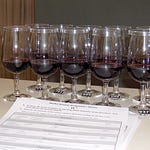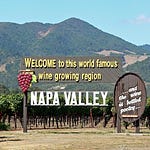This is the weekly column
In our continuing investigation into the world of wine descriptors, we move to common terms.
• Acidity: Key component of wines that “clean the palate” and affect how wine looks, tastes, and ages. The two main acids are tartaric and malic. Hot years/climates reduce acidity. Cold years/climates increase acidity. Acidity preserves freshness and keeps wines lively—very good thing. Too much acidity stomps on fruit flavors and texture—not a good thing. In tasting notes, “good acidity” often means it pairs well with food. Acidity especially is important in white wines and sweet wines.
• Ripe: Grapes achieve ideal level of maturity. Less-mature grapes produce lighter wines with less flavor, more acidity; over-mature grapes produce high-alcohol wines with less acidity. Ripe is the desired spot in the middle. Picking at perfect ripeness can be the most significant decision a winemaker makes in the vineyard.
• Rustic: Describes hearty, earthy wines. Petite sirah and carignane celebrate being called rustic. Rustic tannins can be coarse and chewy, which your palate may or may not love. On the other hand, if an expensive Burgundy is rustic, that is not a good thing. Wine cannot have silky, sophisticated tannins and be rustic at same time. If you like pleasure with a dollop of danger, rustic is good. If you prefer Maurice Chevalier over Arnold Schwarzenegger, rustic may not be the way to go.
• Round: Generally, means wines that have lost youthful, astringent tannins through bottle aging and/or oak aging. Also describes young wines with soft tannins and low acidity. Associated with terms like velvety, creamy, plush, buttery. Generally, a good thing. Unless you lust for rustic.
• Soft: Round, fruity, low in acidity, no aggressive tannins, easy to drink, maybe with a hint of sweetness. Often fruit-forward. Round often is associated with merlot and mass market, supermarket wines.
• Earthy: Little girl with a curl—when good, very good indeed; when bad, horrid. Good: fresh soil, minerals, vegetation, intense expression of the land. Bad: barnyard after cows finish eating. The chemical compound geosmin—a Greek name that translates as “earth smell”—is thought responsible, but the term is not about dirt, rather complexity and depth. Often is referenced in pinot noir, cabernet sauvignon, and syrah.
Tasting notes
• Charles Krug Peter Mondavi Sr. Family Estate Chardonnay, Carneros, Napa Valley 2021: Popular, versatile mainstay from Krug, a fabled Napa maker. 20-25 Link to my review
• Van Duzer Bieze Vineyard Pinot Noir, Eola-Amity Hills, Willamette Valley 2021: Refined delight; congenial pleasure on the palate. $65 Link to my review
Last round
Why do Native Americans disdain rain dances in April? Because April showers bring Mayflowers. Wine time.
Email: wine@cwadv.com
Newsletter: gusclemens.substack.com
Website: gusclemensonwine.com
Facebook: facebook.com/GusClemensOnWine/posts/
Twitter (X): @gusclemens
Long form wine stories on Vocal: Gus Clemens on Vocal















Wine descriptors Part Four 4-24-2024